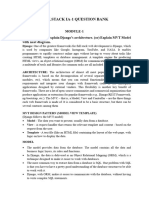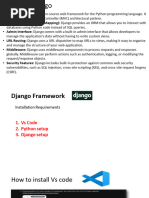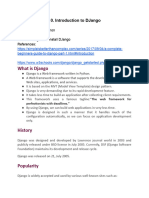0 ratings0% found this document useful (0 votes)
7 views7.Python Web FrameWork
Django is an open-source web application framework for Python that follows the Model-Template-View architecture, enabling the development of dynamic websites and applications. It provides a unified API for different databases and includes components like an object-relational mapper and a templating system. The document outlines Django's architecture, project structure, steps to create a new project, and the files generated during project initialization.
Uploaded by
vinayak457Copyright
© © All Rights Reserved
Available Formats
Download as PDF, TXT or read online on Scribd
0 ratings0% found this document useful (0 votes)
7 views7.Python Web FrameWork
Django is an open-source web application framework for Python that follows the Model-Template-View architecture, enabling the development of dynamic websites and applications. It provides a unified API for different databases and includes components like an object-relational mapper and a templating system. The document outlines Django's architecture, project structure, steps to create a new project, and the files generated during project initialization.
Uploaded by
vinayak457Copyright
© © All Rights Reserved
Available Formats
Download as PDF, TXT or read online on Scribd
You are on page 1/ 3
Python Web FrameWork UNIT-V
5.6 Python Web Application Framework- DJANGO
Django is an open source web application framework for developing web
applications in Python. A web application framework in general is a collection of solutions,
packages and best practices that allows development of web applications and dynamic
websites. Django is based on the Model-Template-View architecture and provides a
separation of the data model from the business rules and the user interface. Django provides
a unified API to a database backend. Thus web applications built with Django can work with
different databases without requiring any code changes. With this flexibility in web
application design combined with the powerful capabilities of the Python language and the
Python ecosystem, Django is best suited for cloud applications. Django consists of an
object-relational mapper, a web templating system and a regular-expression based URL
dispatcher.
5.6.1 Django Architecture:
Django is Model-Template-View (MTV)framework.
Model: The model acts as a definition of some stored data and handles the interactions with
the database. In a web application, the data can be stored in a relational database, non-
relational database, an XML file, etc. A Django model is a Python class that outlines the
variables and methods for a particular type of data.
Template: In a typical Django web application, the template is simply an HTML page with
a few extra placeholders. Django‗s template language can be used to create various forms of
text files (XML, email, CSS, Javascript, CSV, etc.)
View: The view ties the model to the template. The view is where you write the code that
actually generates the web pages. View determines what data is to be displayed, retrieves the
data from the database and passes the data to the template.
Figure 5.12: DJANGO ARCHITECTURE
MRITS/II-II/CSE-IoT/Sensors and Devices 15
Python Web FrameWork UNIT-V
5.6.2 Project Structure:
A Django Project when initialized contains basic files by default such as manage.py,
view.py, etc. A simple project structure is enough to create a single-page application. Here
are the major files and their explanations.
manage.py- This file is used to interact with your project via the command line(start the
server, sync the database… etc). For getting the full list of commands that can be executed
by manage.py type this code in the command window- $ python manage.py help
_init_.py – It is a python package. It is invoked when the package or a module in the
package is imported. We usually use this to execute package initialization code, for
example for the initialization of package-level data.
settings.py – As the name indicates it contains all the website settings. In this file, we
register any applications we create, the location of our static files, database configuration
details, etc.
urls.py – In this file, we store all links of the project and functions to call.
wsgi.py – This file is used in deploying the project in WSGI. It is used to help your Django
application communicate with the webserver.
5.6.3 Steps to create New Project:
_ Create a project
_ Start an application
_ Create the database (MySQL, Postgresql, SQLite)
_ Define DB Settings in Settings.py
_ Define your models
_ Add pluggable modules
_ Write your templates
_ Define your views
_ Create URL mapping
_ Test Application
_ Deploy Application (Linux, Apache, mod_Python, DB)
MRITS/II-II/CSE-IoT/Sensors and Devices 16
Python Web FrameWork UNIT-V
5.6.4 What Django generates:
_ MySite/
_ __init__.py
_ Manage.py // Script to interact with Django
_ Settings.py // Config
_ URLs.py$ // My Site URL mapping
_ MyProject/
_ __init__.py
_ URLs.py // Project specific URL mapping
_ Models.py // Data Models
_ Views.py // Contains the call back functions
_ Admin.py
_ Templates
MRITS/II-II/CSE-IoT/Sensors and Devices 17
You might also like
- E-Note 24867 Content Document 20240927094010AMNo ratings yetE-Note 24867 Content Document 20240927094010AM41 pages
- What Is Django?: By: Madhu Singh (PGT Computer Science) DPSG, Meerut RoadNo ratings yetWhat Is Django?: By: Madhu Singh (PGT Computer Science) DPSG, Meerut Road43 pages
- Django: Python Web Framework Rayland Jeans CSCI 5448No ratings yetDjango: Python Web Framework Rayland Jeans CSCI 544840 pages
- Django Web Framework: Zhaojie Zhang CSCI5828 Class Presenta On 03/20/2012No ratings yetDjango Web Framework: Zhaojie Zhang CSCI5828 Class Presenta On 03/20/201240 pages
- Django Web Framework: Zhaojie Zhang CSCI5828 Class Presenta On 03/20/2012No ratings yetDjango Web Framework: Zhaojie Zhang CSCI5828 Class Presenta On 03/20/201240 pages
- The Ultimate Django Guide: From Beginner to Advanced Web DevelopmentFrom EverandThe Ultimate Django Guide: From Beginner to Advanced Web DevelopmentNo ratings yet
- Computer Project On Django App Creation Theory PartNo ratings yetComputer Project On Django App Creation Theory Part11 pages
- Guide to Django - Building Advanced Websites With PythonNo ratings yetGuide to Django - Building Advanced Websites With Python426 pages
- Chapter 9 - Creating A Django Based Basic Web ApplicationNo ratings yetChapter 9 - Creating A Django Based Basic Web Application11 pages
- Wokring With Python Django-Web Framework Define StatementNo ratings yetWokring With Python Django-Web Framework Define Statement78 pages
- JQuesry + JavaScripting Language by JUNAIDNo ratings yetJQuesry + JavaScripting Language by JUNAID46 pages
- Study Material: Full Stack Web Development With Python and DjangoNo ratings yetStudy Material: Full Stack Web Development With Python and Django21 pages
- (UI Developer) - 2.5 Years: Profile SummaryNo ratings yet(UI Developer) - 2.5 Years: Profile Summary3 pages
- الأمن و الحماية في الإنترنت - الجزء الثانيNo ratings yetالأمن و الحماية في الإنترنت - الجزء الثاني37 pages
- Learn UI UX Design Course Web Certification Training Classes NagpurNo ratings yetLearn UI UX Design Course Web Certification Training Classes Nagpur2 pages
- Web Technology Important 2 Marks and 11 MarksNo ratings yetWeb Technology Important 2 Marks and 11 Marks6 pages
- ABAP - Web Service - Providing and ConsumingNo ratings yetABAP - Web Service - Providing and Consuming55 pages
- Cinput Name-"Firstname": Form Action "/target - HTML"No ratings yetCinput Name-"Firstname": Form Action "/target - HTML"11 pages
















































































































